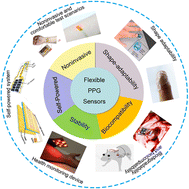Flexible photoplethysmographic sensing devices for intelligent medical treatment
Abstract
The beat frequency, flow rate, and oxygen content of human pulsating blood are important health indicators. For early diagnosis of diseases and real-time monitoring of cardiovascular health in specific practical scenarios, noninvasive methods are used that reduce pain and the risk of infection, but they are not conducive to wound healing. In this field, blood oxygen saturation in humans is obtained based on the use of the medium absorption principle of Lambert Beer's law. Owing to the absorption of light by different substances in the blood, the pulse rate constitutes an important index that is used to assess the status of the cardiovascular system. This study summarizes the research outcomes of sensor devices used for blood oxygen and pulse rate signal monitoring, based on the photoplethysmographic (PPG) test principle, and the main technical means and intelligent application scenarios for improving the shape adaptability, test stability, and biological compatibility of these devices. Nowadays, fabrication technologies are capable of realizing real-time stability in complex practical applications. Based on the research results and the related development status in the field of flexible electronics, some enlightening prospects for the future development of flexible PPG sensors are presented.

- This article is part of the themed collection: Journal of Materials Chemistry C Recent Review Articles


 Please wait while we load your content...
Please wait while we load your content...